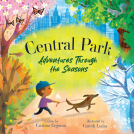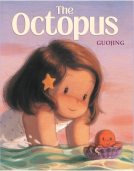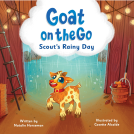
Summertime Sleepers
Animals That Estivate
by Melissa Stewart
This title was previously available on NetGalley and is now archived.
Send NetGalley books directly to your Kindle or Kindle app
1
To read on a Kindle or Kindle app, please add kindle@netgalley.com as an approved email address to receive files in your Amazon account. Click here for step-by-step instructions.
2
Also find your Kindle email address within your Amazon account, and enter it here.
Pub Date Apr 27 2021 | Archive Date Apr 27 2021
Talking about this book? Use #STEM #NetGalley. More hashtag tips!
Description
Everyone knows about animals that hibernate in the winter. But it's time to discover animals that sleep all summer long!
All science classrooms discuss animals that hibernate during winter months, but few know about animals that estivate--a prolonged sleep during hot or dry periods. Dual layers of text awaken readers to the reasons estivating animals become dormant--whether it's because warm weather threatens food supply or to avoid increased body temperatures. From the ladybug to the salamander, from the lungfish to the desert hedgehog, twelve estivating animals and their habits--both when sleeping and awake--are explained through clear text and elegant watercolor illustrations that create a scrapbook feel.
Available Editions
| EDITION | Other Format |
| ISBN | 9781580897167 |
| PRICE | $17.99 (USD) |
| PAGES | 40 |
Average rating from 30 members
Featured Reviews
 Allison D, Librarian
Allison D, Librarian
The kids should find this an interesting book. We spend some time on hibernating, so they'll understand the concept. I like the way the book is organized. Having the different ways of estivating highlighted gives it the feeling of a serious science book while still being pretty easy to read.
 Rachel M, Librarian
Rachel M, Librarian
Really fun read aloud about animals in their habitats. Children will love the illustrations of various animals in different regions. Parents reading this to their children will also enjoy the illustrations.
 Myra Z, Educator
Myra Z, Educator
The engaging illustrations and interesting information provided in this book make it an excellent choice for young readers. Using both notebook sketches and watercolor illustrations, the artwork shows how animals estivate, or sleep when it is too hot for them to be up and about. The information is clearly organized by how the animal estivates, or sleeps. For example, some insects snooze in groups, while some rest alone. The tone is friendly and inviting, and the information is interesting and clearly reveals the variety of animal adaptations. By contrasting estivation with hibernation and providing multiple examples of how animals estivate, this book promotes comprehension and processing. The author’s note, telling how she “found” the topic, researched it, selected the list format and the compare and contrast format, worked with her editor, and revised the work is very valuable. So too, is the illustrator’s note discussing how she planned the illustrations, using small sketches of animals being active and larger watercolor illustrations of them resting. An excellent example of how nonfiction involves creative choices of how to present information.
 catherine h, Reviewer
catherine h, Reviewer
I haven't seen to many books on estivation, but this one is much needed and a real delight! Loved the animals showcased in this book. I had no idea what killifish were before this book but was astounded that they could flip themselves into logs and shut themselves down until the rains came! Who knew fish could do that? Nature is amazing. I think that this book would make a fine edition addition to a science collection ,or a wonderful gift for a child who enjoys nature! I liked the illustrations; nice details!
This book talks about Estivation. Its the Hibernation that happens in the summer. This book does a great job at talking about numerous different animals that do this. Each animal had a page that talked about how they hibernate, for how long, and then there are pictures drawn to show how the animal does it. I would recommend this book to any classroom that talks about hibernation. It would be an added helpfulness to the topic.
A book about the little know animals that estivate vs hibernate. I think this book is wonderfully illustrated and very informative for young and old readers alike!
 Donna M, Reviewer
Donna M, Reviewer
I really like this book and the illustrations were lovely!
The book focussed on Estivation and animals that sleep all through the summer – most children will have heard of hibernation – but how many have heard of Estivation?
The book is well written and easy to follow and understand. The book focused on a great mix of different species too so there is also plenty to learn and it is a fun book too.
It is 5 stars from me for this one – a great idea that was well developed and is very highly recommended!
 Natalie H, Reviewer
Natalie H, Reviewer
I received an advance reader copy of this book to read in exchange for an honest review via netgalley and the publishers.
Summertime sleepers is a delightful children's book about animals who estivate in the warm months of the year. This is the first book I have come across about estivationas the usual books I have come across are always about hibernation.
Each page is about a different animal or creature, and has a fact file about the animal and a page of information about how they estivate. I really enjoyed reading this and know the children I work with will find it fascinating!
 Bill C, Reviewer
Bill C, Reviewer
Summertime Sleepers: Animals that Estivate, written by Mellissa Stewart and illustrated by Sarah S. Brannen, is an engaging and informative children’s book. The text is simple and plain (for the most part), making it easy to follow for young readers/listeners. Every now and then I’d say a word falls a bit flat or awkward, but for the most part the text flows smoothly.
It’s not particularly lyrical, but does make nice use of some poetic techniques, such as alliteration and assonance, as per the following examples:
• “warm weather”
• “searches for shelter”
• “snug spots and sink into summertime sleep”
• “snooze in groups”
Despite the brevity required of a picture book, Stewart does a nice job of conveying the factual part clearly as well as concisely. Animals covered include the mourning cloak butterfly, lungfish, the California tiger salamander, pixie frogs, and desert hedgehogs. There’s also a separate paragraph for each animal in the back matter giving 2-3 lines of more information about them, an explanation of the difference between estivation and hibernation, a further reading bibliography, and a brief personal note from the author and one from the illustrator.
As for the illustrations, the animal sections present several types. One is the animal in its estivating setting—these are warmly colorful and nicely uncluttered. Each also has an included inset illustration down in black on an off-white background showing a more fact-based/scientific illustration of the animal, with its full name, its scientific name, its size, and drawings of it in actual size if possible or to a given scale, and also enlarged.
Lucid, smooth flowing, good read-aloud text and colorful, simple drawings all combine to make a very good non-fiction book for young children.
 Becka G, Reviewer
Becka G, Reviewer
Prior to this book I was unfamiliar with the term estivate.
This is a really cute way to teach kids (and adults alike) about Summer Sleepers.
Nice illustrations and small descriptions on why they estivate on each animal.
There is more information in the back, including a comparison of hibernation vs estivation.
The author then includes other titles to help explore further into seasonal slumbering animals.
Definitely something I would include with all tiny human reading rotations.
Much love to NetGalley & Charlesbridge for my DRC.
 Educator 672695
Educator 672695
Loved Summertime Sleepers, from the illustrations to the interesting information about animals that estivate. Usually we can build units around animals that hibernate and winter. Summer Sleepers gives an opportunity to talk about other animals that sleep but not in the winter but in summer. Even opening up the opportunity for your students to research animals that estivate. The illustrations aided in helping the book feel more like a field journal with the drawings, measurements and actual size of the animals being investigated.
 Mell K, Reviewer
Mell K, Reviewer
I am 26 years old and I had no idea there are animals that estivate.
This was cute and educational, and the art was quite nice.
I had never heard of the word estivate until I read this book. Summertime Sleepers was fascinating! I felt like I was sneaking a peek at a biologist's field guide. I will never look at a bunch of lady bugs the same again. A perfect book for your little explorer!
 Reviewer 186721
Reviewer 186721
I think the title didnt hit me.. not even the crossing out of Hibernation and the red color estivation. Wow, didnt know that animals slept in summer too. Cool finding. And variety of animals seem to be doing it. Colorful illustrations and pencil drawings.
 Reviewer 785419
Reviewer 785419
Beautiful illustrations with soft looking pictures. This book was also interesting and informative. Very nice choice for a child’s bookshelf and bedtime story.
Beautifully illustrated, this book satisfies young readers cravings for unusual animal facts. I also like the inclusion of the latin taxonomy as well as the size, with many illustrations drawn to scale. The illustrations have a field sketch quality that I like to show students as examples of how to include pictures in journals.
 Carla J, Reviewer
Carla J, Reviewer
So, I am a retired teacher, but have never heard the term, Estivate. Summertime sleepers is a wonderful children's book about animals who sleep, or estivate, in the warm months of the year. I had never heard this term or read about this topic. We all knew about hibernation, even the 4 year old, so this was a family educational experience. It is written in a simple, easy to understand way for children. Each page is about a different animal or creature. It tells up how they estivate and why. There are just enough facts to pique the interest of an older child to possibly do more research. The illustrations are very well done, with text boxes, labels and pop up facts to make this book more of a science text than a story. The animals highlighted were not all well-known, so not only did we learn about a new animal activity, we learned about a few new animals. We enjoyed reading this book together and learning about a new animal activity. I definitely recommend this one for classroom, school and public libraries.
 Reviewer 626008
Reviewer 626008
I'd never heard of animals that sleep in the summer (or estivate), but it does make perfect sense. Who doesn't 'want to pass extremely hot summer days lazing about, trying to expend as little energy as possible in order to keep cool?
Nice illustrations and good information, 4 stars.
 Karen A, Librarian
Karen A, Librarian
I have long enjoyed Melissa Stewart’s books. The concept of summer animals taking a break was new to me and would intrigue children accustomed to learn
Ning about hibernation. The illustrations are detailed, visually appealing, and worth pausing over.
Very cute informal book about animals and the type of sleepers they are. Totally a ece book that would be in my classroom
 Candice G, Educator
Candice G, Educator
This is a wonderful nonfiction pb about summer sleepers or estivation. This 4th grade teacher learned a lot about the animals that estivate (the equivalent of hibernate) during the summer months. The book contains many animals that estivate and gives information, illustrations, and diagrams of each one. This is a great book for learning about animals and their sleep cycles. I received this as an advanced read from NetGalley.
 Sharon T, Reviewer
Sharon T, Reviewer
Summertime Sleepers: Animals That Estivate is a nonfiction picturebook written by Melissa Stewart and illustrated by Sarah S. Brannen. It is currently scheduled for release on April 27 2021.
All science classrooms discuss animals that hibernate during winter months, but few know about animals that estivate--a prolonged sleep during hot or dry periods. Dual layers of text awaken readers to the reasons estivating animals become dormant--whether it's because warm weather threatens food supply or to avoid increased body temperatures. From the ladybug to the salamander, from the lungfish to the desert hedgehog, twelve estivating animals and their habits--both when sleeping and awake--are explained through clear text and watercolor illustrations that create a scrapbook feel.
Summertime Sleepers: Animals That Estivate is a realistically illustrated introduction to something I have not really thought about, or learned much about, over the years. I had read about specific animals that estivate, but did not know the range of creatures that have this unique skill, and the variety of reasons and forms it can take. I thought the text and artwork were well balanced, and the text was well worded, making it accessible without stepping over the line into condescending. I really enjoyed that there was additional informational text at the end of the book.
 Penny P, Librarian
Penny P, Librarian
Using a scrapbook-like format, this simple nonfiction book describes various animals that lie dormant in hot or summer weather (meaning they estivate instead of hibernate). Twelve different creatures are profiled in two-page spreads, using a dual text. There is an easy one-sentence text to read aloud to a group or class, and a paragraph in smaller print with more details for older readers to explore. Animals featured include the ladybug, yellow-bellied marmot, land snail, and California tiger salamander. The full color watercolor illustrations show each animal in close-up alongside an ink drawing on a white background. The book ends with more facts about the animals featured in the main text, a list of other books on the subject, author and illustrator notes, and sources. A great addition to units on migration and hibernation.
As a child we all learned about hibernation
But have you ever heard of 'estivation'?
Beautiful illustrations alongside interesting facts will delight young ánd old!
Read about all these animals who - during summer - put their lives on hold
***************************************************
INTERESTING PHENOMENON
Everyone knows animals who sleep their way through wintertime.
But can you name some who sleep during summer?
Have you ever even heard of this phenomenon which is called 'estivation'?
Most of us haven't.
Neither did Melissa Stewart.
Until a hot June day in 2011, when she was scanning the shelves in the natural history section of her town library and stumbled on a 250-page tome on hibernation. It contained only a single paragraph on estivation.
But that was enough to spark her curiosity and to get her searching for more info in science journals and their reference sections.
Thanks to her perseverance to present her gained knowledge in an attractive picture book, more people will now be able to learn about this less known phenomenon.
The beautiful illustrations are made by Sarah S. Brannen.
She has clearly put a lot of thought in the way of presentation of the animals. As she also explains in an afterword, she had to show animals in sleeping positions. But how could she avoid a too sleepy feeling or too static images?
An original idea occured to her: she would show the animals both sleeping and wide-awake.
To make a clear distinction, she made warm watercolors of the animals when they are resting. These main illustrations reveal how and where each animal estivates.
Alongside these watercolors there are also black-and-white sketchbook pages picturing the animals when they're awake. On these drawn sketches Melissa was able to share more of the scientific information she gathered, like the size of the animals, in which part of the world to find them and some other interesting facts.
And it must be said: this concept turned out brilliantly!
To get an idea of how it looks like, you can take a look at the animated movie at https://www.sarahbrannen.com/summertime
A BOOK THAT GROWS ALONG
At the end of the book there are three pages of text in which a bit of additional info is given about the discussed animals.
Some readers believe that it would've been better if all the info about each animal was bundled in one place instead of a part being presented along with the pictures and another part at the end of the book.
But you could also consider this structure as an asset, because it makes this book very well suited for different kinds of public and thus can 'grow along' with the (increasing interest of) children.
Young children can simply go through the book without going into the details and just be amazed by the colorful pictures and all these special animals.
Children who are a bit older can read the extra information at the end of the book which creates more depth and allows them to dive deeper into the subject of estivation (if they wish to do so).
For all the curiosity seekers (and especially adults) there's also the mentioning of extra source material which form excellent starting points if you wish to learn more about this fascinating subject.
STEM
More and more children's books fall under the category of STEM-books.
For those who don't know what STEM means, it's the abbreviation for four closely connected areas of study: science, technology, engineering and mathematics.
One thing's for sure: this is an absolute topper in the genre!
Firstly, it's based upon a lesser known subject which makes it interesting for both young ánd old.
Secondly, this book can be used to teach various STEM-subjects. Because not only does it bring biology to life, but geography as well. Let children search on a world map where the animals live, let them search for extra information on the internet, …
Actually there are so many teaching options thinkable, not only at home but also (and maybe foremost) at school. If you're short of ideas, make sure to take a look at the book extensions on Melissa's website! In the right column you'll find a Teacher's guide, Read aloud guide, Readers theater, Revision decisions (interactive teaching tool) and a video Rockin' Research.
Go to: https://www.melissa-stewart.com/books/mammals/bk_summertime_sleepers.html
WARNING
This book can have serious side effects. The most reported one is that it makes you really want to know even more about estivation.
(For your information: Aestivation has a total different meaning when you talk about flowers instead of animals! It then refers to the mode of arrangement of sepals or petals in a flower bud with respect to one another)
Out of curiosity I looked around on the internet.
Although there isn't that much material available, I found some really interesting footage.
If you want, you can head over to my blog World of Tau to view some short movies: https://world-of-tau.blogspot.com/2021/05/summertime-sleepers.html
The website of author Melissa Stewart can be found at: https://www.melissa-stewart.com/index.html
The website of illustrator Sarah S. Brannen can be found at https://www.sarahbrannen.com
*Thanks to NetGalley and Charlesbridge for providing a digital copy of this book in exchange for an honest review.
 Cara M, Librarian
Cara M, Librarian
I loved this book, featuring animals with different life patterns than we often learn about. Children are taught about nocturnal and diurnal animals, about those who hibernate in winter, but I for one had not heard of animals that sleep through the heat of summer. Informative with fun illustrations, children will love learning about this new category of animals.
Readers who liked this book also liked:
Sam Morrison
Children's Nonfiction, Crafts & Hobbies, Outdoors & Nature
Natalie Horseman
Children's Fiction, Outdoors & Nature, Parenting, Families, Relationships


















